MARIANAS, June 19, 20 1944 - Historycal Background
Posted: Fri Jan 27, 2012 12:43 pm
Pilots & Gentlemen
Giving our warmest Welcome to all IL-2 International Community to this new Event, thanking all Sqn. Teams for their participation, hoping a great amusement for all Pilots, recommending the maximum loyalty and fair play in spirit of Airmen Brotherhood, for the occasion please find hereinafter the Historical Background of those dramatic Events which, all together, we will try to reenact.
A Great Salute to All!
SEOW MARIANAS Org.
_________________________________________________________________________
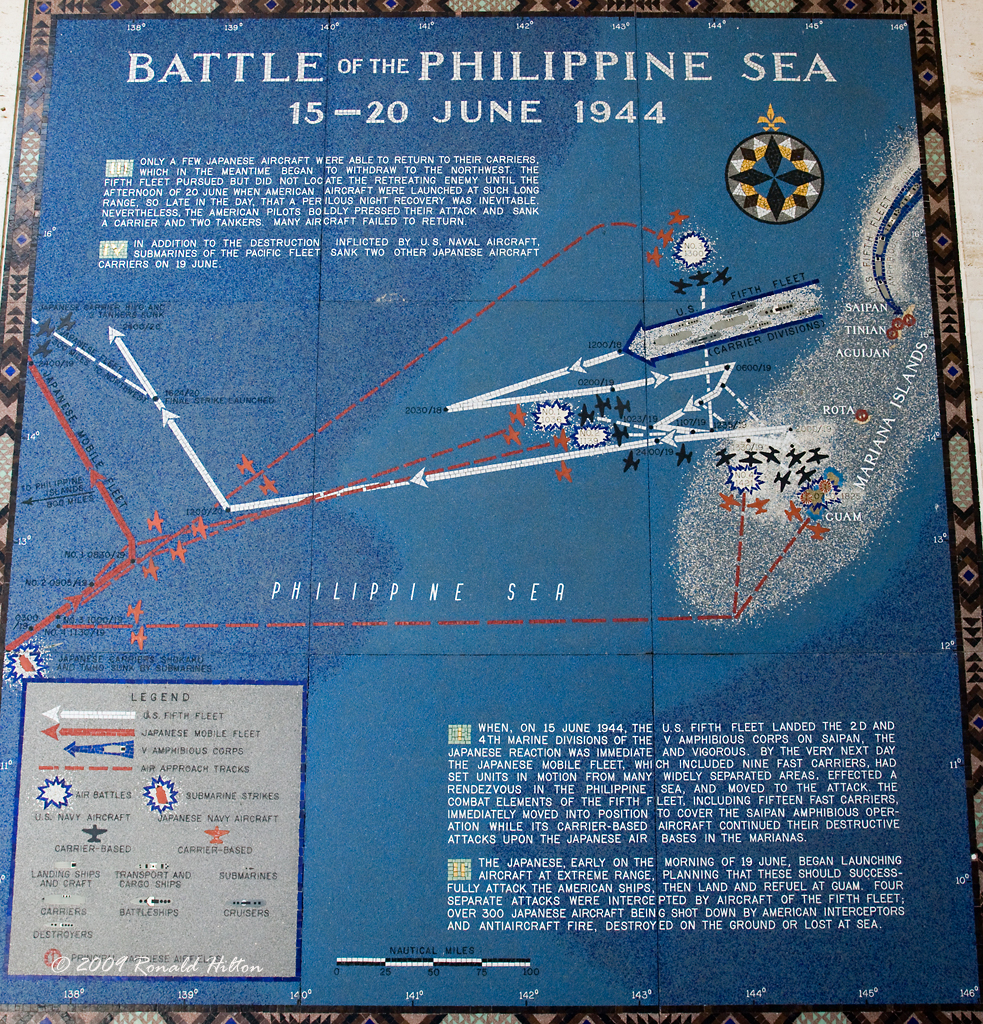
Sea American Memorial, Philippines
THE MAJOR CARRIER VS CARRIER BATTLE IN HISTORY - MARIANAS ISLANDS, 19, 20 June 1944
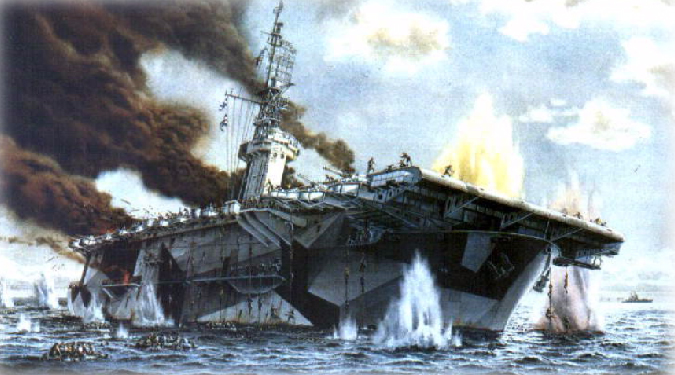
Belligérants
 United States Fifth Fleet
United States Fifth Fleet
Commanders

Raymond A. Spruance

Marc A. Mitscher
Strength
7 Fleet Carriers
8 Light Carriers
7 Battleships
8 Cruisers
12 Light Cruisers
67 Minor Ships
22 Submariners
956 Aircraft
99.000 Personnel

USS Lexington CV16-10
 Japan Combined Fleet
Japan Combined Fleet

Jisaburo Ozawa

Kakuji Kakuta
Strength
5 Fleet Carriers
4 Light Carriers
5 Battleships
12 Cruisers
2 Light Cruisers
43 Other Ships
680 Aircraft (of which 250 land based aircraft)

HIJMS Taiho
The Battle of the Philippine Sea (June 19–20, 1944), well known also with the name of Marianas Battle, was a decisive naval battle of World War II which effectively eliminated the Imperial Japanese Navy's ability to conduct large-scale carrier actions. It took place during the United States' amphibious invasion of the Mariana Islands during the Pacific War. The battle was the fifth of five major "carrier-versus-carrier" engagements between American and Japanese naval forces, and involved elements of the United States Navy's Fleet as well as ships and land-based aircraft from the Imperial Japanese Navy's Combined Fleet and nearby island garrisons.

Map of Battle
Background
The Battle of the Philippine Sea came about as the Americans invaded Saipan because the Japanese staff judged that it could pin the American Fleet against the island while the Americans were protecting their transports and the beachhead. It was fought between the carrier aircraft put up by the United States Navy's Fleet and both the land based and carrier launched naval air craft launched by the Imperial Japanese Navy's Combined Fleet and Japan's island garrisons.
The Japanese naval staff had hoped to resume offensive carrier operations in early 1944 and was still training pilots and new carrier crews when it decided to counterattack against the U.S. invasion fleet attacking the beaches of Saipan in the first stages of its Mariana Islands invasion.
On 19 April 1943, Admiral Mineichi Koga succeeded Yamamoto as Commander in Chief of the Combined Fleet. Under his direction in September 1943, Imperial Japanese Navy Headquarters decided the time was right to return to the offensive in the Pacific. But soon, because U.S. forces were attacking Japanese-held islands in the course of its “island hopping campaign” attack against the Japanese Sea lines of communications (SLOCs) the offensives planned could not be sustained despite ample sufficient naval aircraft production rates. The lack of trained carrier pilots meant the air fleets could not be manned and the Americans were attacking the land bases.
The staff morphed their planning into a carrier assisted battle fleet attack on the U.S. invasion fleet that would be pinned protecting transports and forces just landed. This 'battleships are still king' conceptualization was still prevalent in some U.S. circles as well, but not among the operational commanders. The battle fleet sortie concept was very similar to that intended by the late Admiral Yamamoto in the battle of Midway. Many of the officers who had planned Midway were still on the General Staff of the Combined Fleet. In their planning it was believed that the lack of offensive air power could be addressed by deploying strong land-based air forces a natural connection, for Japan had taken pains build many bases that could control the SLOCs around themselves.
Operation A-Go
The initial plan was to attack the U.S. Pacific Fleet in early 1944 whenever it launched its next minor offensive. However, the U.S. fleet was integrating and training up multiple new technologies, vast reinforcements, and developing new operational doctrines that made it far more effective than the Japanese imagined. The U.S. fleet retook the offensive by going after the air bases in a succession of raids designed to deplete and defeat control of the SLOCs around each base. It had taken U.S. commanders over a year and a half to incorporate radar into their practices after the first radar sets were deployed. The Japanese commanders were far worse off, with no inkling of the power of the new technology.
In March, Japan's combined fleet again lost its commander in an aircraft, this time during a Pacific hurricane. Under direction of the newly appointed Commander in Chief of the Combined Fleet, Admiral Soemu Toyoda, a finalized plan for the new conditional 'offensive' dubbed "Plan A-Go", or "Operation A-Go" was adopted in early June 1944, then within weeks, quickly adapted to trap the American fleet now detected in the process of invading Saipan.
Strategically, the Japanese commanders considered Guam, Tinian, and Saipan as part of an inner air-sea defense ring of land based fighter and bomber bases surrounding and protecting their home islands. In the prior year, the U.S. fleet had worked its way over or past other such strongholds in their steady progression across the Central Pacific islands. Their offensive served to weaken the Japanese naval air capabilities, so the Imperial Staff calculated the Marianas would come under similar attack. While revising their offensive ambitions the Japanese staff also ordered prepared defenses and planning for various likely island bases they believed would be likely targets.
The Japanese war plan had from the start always been to inflict such severe and painful losses upon the Americans that the American public would become war weary and demand a negotiated settlement. American technological advances and material production capacity made this objective impossible by holding down U.S. casualties. American-Allied spirits didn't flag but grew more resolved as the war went on.
Furthermore, the U.S. commanders turned the strategy around on the Japanese. Admiral Chester W. Nimitz and General Douglas McArthur planned large fighter strikes to surprise, overwhelm and suppress local and nearby island air bases and their mobile forces eliminating the material assets needed for the Japanese plan to be effective. Both commands then followed up invading a select key Japanese base by amphibious assaults where they'd emplace their own bases before hopping farther up the Japanese supply chain (SLOC) to take other key strong points. This hopping step by step from key position to key position neutralized the remnant forces and war material left behind on the bypassed Japanese bases.
That McArthur's forces applied this strategy along the long length of New Guinea instead of against isolated island bases is immaterial, for the dense triple-canopy jungles of New Guinea effectively demanded Sea Lines of Communication just to move a few miles. Similarly, it didn't matter that the General's offensive strikes were led sometimes by borrowed aircraft carrier strikes or the Army Air Corps' long ranged P-38 fighters of the U.S. Fifth Air Force. These cut off garrisons effectively withered most of the time towards near starvation, except as they turned their energies and efforts to local food production and away from military operations as they could no longer be supplied save by submarine or daring but fuel wasteful high speed destroyer runs, and material deficiencies could no longer be fixed. Consequently, the Japanese more often than not evacuated units bypassed rather than continuing to stretch logistics supporting units in untenable situations.
The Japanese society, for cultural reasons had difficulty training replacement pilots and no long term preparatory training program had been anticipated in pre-war planning that would enable the country to overcome their tradition caused cultural bottleneck causing a shortage of new pilots until well into the war. Many of these air to air losses are also largely attributed to the obsolescence of the Japanese aircraft for where the United States had researched and designed entire new classes to cope with the Japanese early war equipment superiority. Culturally the Japanese war society's entrenchment in Bushido (way of the warrior) philosophy suggested few such similar improvements from the 'obedient unquestioning warriors' in the field sent up the ladder to the leadership in the top down cultural hierarchy. The Japanese simply had no such feedback mechanism to duplicate the free wheeling out-spoken American character providing quick and effective pointed complaint feedback to designers.[dubious – discuss]
Hence before the end of 1942 the allied navies had by and large overcome most of the technological edge's Japan's ships and planes had held at the war start and furthermore by mid-1943 had the improvements in rapid mass production or were already updating ships and deploying improved aircraft in a continual process of improvement to correct such deficiencies. The Allied educational training practices similarly had geared up and flexibly adapted to new developments, along the way totally revising the way the American fleet operated with the parallel development of both the Combat Information Center and doctrine, training and practices to get the most out of the new communications and sensor technologies.
Most of Japan's more skillful and experienced pilots had died during the two years of attrition of near continual engagements as the U.S. stabilized the theater in 1942 with the blooding battles at Coral Sea and Midway where they checked and all but stopped Japanese expansion. The war events then began draining down the talent level of Japan's land based air forces as well with progressive air fleet activities in the New Guinea campaign and the tentative U.S. offensive, the battle of attrition that was the Guadalcanal campaign which by the fall of 1942 had decimated the average skill level of Japan's land and sea based pilots by taking out the best of them in the grinding battles. In 1943-44 other island war engagements just exacerbated the problem from the Japanese point of view as the U.S. fast carrier task groups began purposefully to raid and pound Japanese island stronghold specifically to reduce their air power and ability to protect shipping.
Moreover, the U.S., Australian, and British cultures and societies had added a comparative flood of well trained systematically seasoned pilots themselves trained by seasoned pilots recently rotated from the front to the 'finishing school' training commands. Additional training and experience effects from the long pilot shortage was the resultant inexperience of the Japanese carrier deck crews, not just its newbie aircrews flying the same unimproved well understood planes with the same old weaknesses, for in contrast to the U.S. Navy's operational tempo which had grown steadily from mid-1943 Japan's older and newly commissioned aircraft carriers sat in port awaiting hastily trained pilots to arm and justify their existence while the U.S. Fleet had totally re-equipped with the more modern Grumman F6F Hellcat fighter, which was specifically designed to be superior to the Japanese Zero. Further, the increased operations had just further seasoned its better-trained and more experienced airmen and replacement, while training up fleet personnel from Seaman to Admiral on other important new developments from its Combat Information Center organized and directed fleet anti-air defenses, to radar-directed combat air patrols, and the deployment of the VT Fuze in ship-based anti-aircraft artillery where task group CIC's directed the massed gunfire of neighboring ships.
The Japanese fleet, commanded by Vice-Admiral Jisaburo Ozawa, consisted of five large carriers (Taihō, Shōkaku, Zuikaku, Junyō, and Hiyō), four light carriers (Ryuho, Chitose, Chiyoda, and Zuihō), five battleships (Yamato, Musashi, Kongō, Haruna and Nagato) and supporting cruisers, destroyers, and oilers.
On June 12, 1944 U.S. carriers started a series of air strikes on the Marianas, convincing Admiral Toyoda that the U.S. was preparing to invade. This move came as a surprise; the Japanese had expected the next U.S. target to be farther to the south, either the Carolines or the Palaus. Therefore, the Marianas were protected with only 50 land-based aircraft.

USA amphibious forces approaching Saipan
On June 13, U.S. forces began bombardment operations for invading Saipan; in response, Toyoda ordered a fleet-based counterattack. The main portions of the fleet, consisting of six carriers and several battleships, rendezvoused on June 16 in the western part of the Philippine Sea and completed refueling on June 17.


On Saipan sands
La porzione principale della flotta, consistente di sei portaerei e di numerose navi da battaglia si incontrò il 16 nella parte occidentale del Mare delle Filippine, completando i rifornimenti di carburante il 17 giugno successivo.
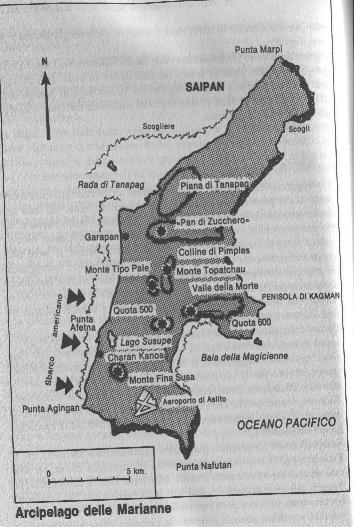
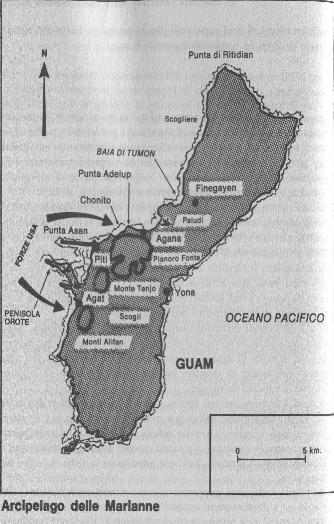
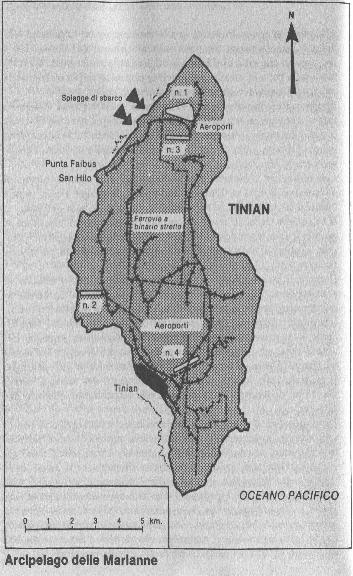
Landing on Saipan, Guam e Tinian
American response
The Japanese fleet was sighted on June 15 by American submarines and by the next day Admiral Raymond Spruance, commander of the U.S. 5th Fleet, was convinced that a major battle was at hand. By the afternoon of June 18, Vice Admiral Marc Mitscher, aboard his flagship (the carrier USS Lexington) had his Task Force 58 (the Fast Carrier Task Force) formed up near Saipan to meet the Japanese attack.
TF-58 consisted of five major groups. In front (to the west) was Vice Admiral Willis Lee's Task Group 58.7 (TG-58.7), the "Battle Line", consisting of seven fast battleships (Washington, North Carolina, Indiana, Iowa, New Jersey, South Dakota and Alabama). Just north of them was the weakest of the carrier groups, Rear Admiral William K. Harrill's TG-58.4 of three carriers (Essex, Langley and Cowpens). To the east, in a line running north to south, were three groups each containing four carriers: Rear Admiral Joseph Clark's TG-58.1 (Hornet, Yorktown, Belleau Wood and Bataan); Rear Admiral Alfred Montgomery's TG-58.2 (Bunker Hill, Wasp, Cabot and Monterey) and Rear Admiral John W. Reeves's TG-58.3 (Enterprise, Lexington, San Jacinto and Princeton). The capital ships were supported by eight heavy cruisers, 13 light cruisers, 58 destroyers, and 28 submarines.
Shortly before midnight on June 18, Admiral Chester W. Nimitz sent Spruance a message from Pacific Fleet Headquarters indicating that the Japanese flagship was approximately 350 miles (562 km) to the west-southwest of Task Force 58. This was stated as based on a "fix" obtained by radio direction-finding, but was more probably due to decryption of intercepted Japanese naval messages.
Mitscher realized that if Task Force 58 were to advance westward, there was a strong chance of a night surface encounter with Ozawa's forces. He therefore conferred with Lee and inquired whether Lee favored such an encounter. The battleship commander was not enthusiastic about a night engagement with Japanese surface forces, despite his new ships outclassing most of the Japanese battleships, feeling that his crews were not adequately trained for such an action. Shortly after his discussion with Lee, Mitscher asked Spruance for permission to head west during the night to reach what would be an ideal launch position for an all-out aerial assault on the enemy force at dawn.
However, Spruance refused. Throughout the run-up to the battle he had been concerned that the Japanese would try to draw his main fleet away from the landing area using a diversionary force, and would then make an attack around the flank of the U.S. carrier force, an "end run", hitting the invasion shipping off Saipan. He was therefore not prepared to let Task Force 58 be drawn westward, away from the amphibious forces, as he was aware that Japanese operational plans frequently relied on diversionary forces. On this occasion, however, there was no such aspect to the Japanese plan; there was no ruse and no diversionary force.
The Battle. First actions. June 19

Ozawa's Raids
At 05:30 on June 19, TF-58 turned northeast into the wind and started to launch their air patrols. The Japanese had already launched their morning search patrols using some of the 50 aircraft stationed on Guam, and at 05:50, one of these, a Mitsubishi Zero, found TF-58. After radioing his sighting of U.S. ships, he attacked one of the destroyers on picket duty and was shot down.

Fighter aircraft contrails mark the sky over Task Force 58, June 19, 1944
Thus alerted, the rest of the Guam forces began forming up for an attack, but were spotted on radar by U.S. ships, and a group of F6F Hellcats from the Belleau Wood were sent to investigate. The Hellcats arrived while aircraft were still launching from Orote Field. Minutes later, additional radar contacts were seen, which were later discovered to be the additional forces being sent north from the other islands. A huge battle broke out; 35 of the Japanese aircraft were shot down, and the battle was still going an hour later when the Hellcats were recalled to their carriers.

F6F-3 landing aboard 'Lexington' (CV-16) — Task Force 58 flagship
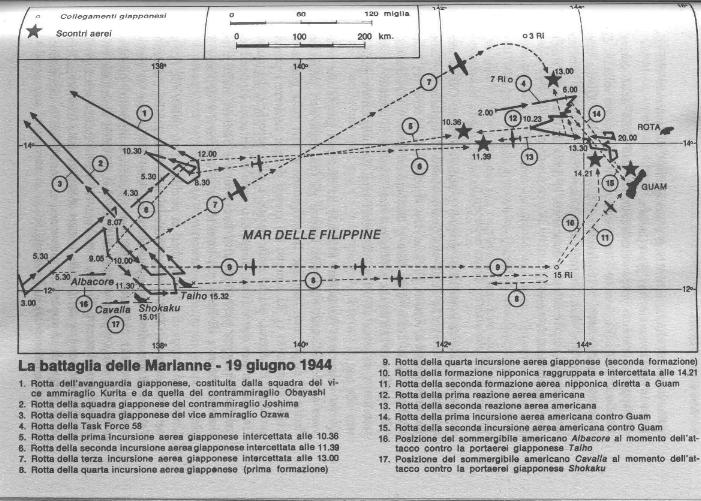
Battle Map, June 19
Japanese raids
The recall had been ordered after several ships in TF-58 picked up radar contacts 150 miles (240 km) to the west around 10:00. This was the first of the raids from the Japanese carrier forces, with 68 aircraft. TF-58 started launching every fighter it could, and by the time they were in the air, the Japanese had closed to 70 miles (110 km). However, the Japanese began circling to regroup their formations for the attack. This 10-minute delay proved critical, and the first group of Hellcats met the raid, still at 70 miles (110 km), at 10:36. They were quickly joined by additional groups. Within minutes, 25 Japanese aircraft had been shot down, against the loss of only one U.S. aircraft.
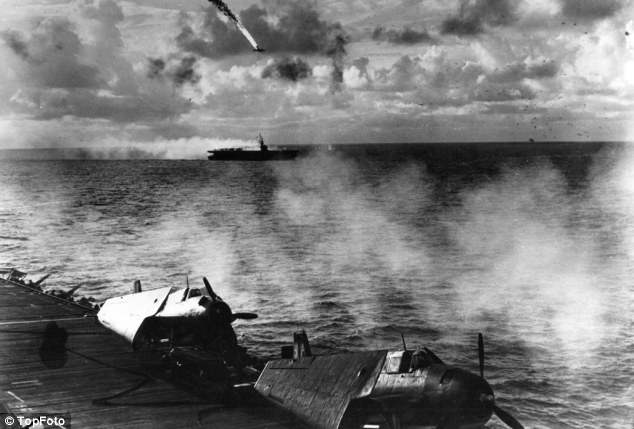
Japanese aircraft dive in flame
The Japanese aircraft that survived were met by other fighters, and 16 more were shot down. Of the remainder, some made attacks on the picket destroyers USS Yarnall and USS Stockham but caused no damage. Three or four bombers broke through to Lee's battleship group, and one made a direct hit on the USS South Dakota, which caused many casualties, but failed to disable her, being the only Japanese success throughout the battle. Not one aircraft of Ozawa’s first wave got through to the American carriers

USS South Dakota
At 11:07, radar detected another, much larger attack. This second wave consisted of 107 aircraft. They were met while still 60 miles (97 km) out, and at least 70 of these aircraft were shot down before reaching the ships. Six attacked Rear Admiral Montgomery’s group, nearly hitting two of the carriers and causing casualties on each. Four of the six were shot down. A small group of torpedo aircraft attacked Enterprise, one torpedo exploding in the wake of the ship. Three other torpedo-aircraft attacked the light carrier Princeton but were shot down. In all, 97 of the 107 attacking aircraft were destroyed.
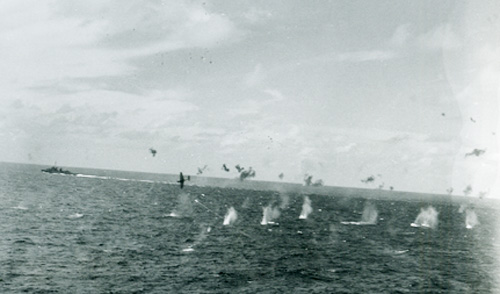
Air attacks against the Task force 58, morning June 19
The third raid, consisting of 47 aircraft, came in from the north. It was intercepted by 40 fighters at 13:00, while 50 miles (80 km) out from the task force. Seven Japanese aircraft were shot down. A few broke through and made an ineffective attack on the Enterprise group. Many others did not press home their attacks. This raid therefore suffered less than the others, and 40 of its aircraft managed to return to their carriers.
USS Bunker Hill is nearly hit by a Japanese bomb during the air attacks of June 19, 1944.The fourth Japanese raid was launched between 11:00 and 11:30, but pilots had been given an incorrect position for the US fleet and could not locate it. They then broke into two loose groups and turned for Guam and Rota to refuel. One group flying toward Rota stumbled upon Montgomery’s task group. Eighteen aircraft joined battle with American fighters and lost half their number. A smaller group of nine Japanese dive bombers of this force evaded U.S. aircraft and made attacks on the USS Wasp and the USS Bunker Hill, but failed to make any hits. Eight of these aircraft were shot down in the process. The larger group of Japanese aircraft had flown to Guam and were intercepted over Orote Field by 27 Hellcats while landing. Thirty of the 49 Japanese aircraft were shot down, and the rest were damaged beyond repair.

USS Bunker Hill is nearly hit by a Japanese bomb during the air attacks of June 19, 1944.
Aboard the Lexington afterward, a pilot was heard to remark "Hell, this is like an old-time turkey shoot!" Since then, this lopsided air battle has been known as the “Great Marianas Turkey Shoot”.
Including the continued aerial slaughter over Orote Field, Japanese losses exceeded 350 planes on the first day of battle. American losses were slight, about thirty planes were lost. American ship damage was minimal.
Most of those who successfully evaded the US fighter screens were aviators who were seasoned veterans of the six-month Japanese advance early in the Pacific war, the South Pacific campaign and survivors of the Battle of Midway.
Submarine attacks

HIJMS Taiho
At 08:16 the submarine USS Albacore had sighted Ozawa’s own carrier group and began an attack on the closest carrier, which was Taihō, the largest and newest carrier in the Japanese fleet and Vice Admiral Jisaburo Ozawa’s flagship. As Albacore was about to fire, however, her fire-control computer failed, and the torpedoes had to be fired “by eye”.
Taihō had just launched 42 aircraft as a part of the second raid. Four of Albacore’s torpedoes were off-target. Sakio Komatsu, the pilot of one of the recently-launched aircraft, sighted one of the two which were heading for Taihō and crashed his aircraft on it, but the last torpedo struck the carrier on her starboard side, rupturing two aviation-fuel tanks. At first, the damage did not appear to be very serious.

HIJMS Shokaku
Another submarine, USS Cavalla, was able to maneuver to an attack position on the 25,675-ton carrier Shōkaku by about noon. The submarine fired a spread of six torpedoes, three of which struck the Shōkaku. Badly damaged, the carrier came to a halt. One torpedo had hit the forward aviation fuel tanks near the main hangar, and aircraft that had just landed and were being refueled exploded into flames. Ammunition and exploding bombs added to the conflagration, as did burning fuel spewing from shattered fuel pipes. With her bows subsiding into the sea and fires out of control, the captain gave orders to abandon ship. Within minutes, total catastrophe struck the vessel. Volatile gas fumes had accumulated throughout the vessel, and when an aerial bomb exploded on the hangar deck, a series of terrific explosions simply blew the ship apart about 140 miles (230 km) north of the island of Yap. The carrier rolled over and slid beneath the waves taking 887 navy officers and men plus 376 men of Air Group 601, a total of 1,263 men in all, to the seabed. There were 570 survivors, including the carrier's commander, Captain Hiroshi Matsubara. Futile attempts were made by destroyer Urakaze to destroy the submarine, but Cavalla escaped with relatively minor damage due to depth charge near misses from Urakaze.
Meanwhile, Taihō was falling victim to poor damage control. On the orders of an inexperienced damage-control officer, her ventilation system had been operating at full-blast in an attempt to clear explosive fumes from the ship. This instead had the effect of spreading the vapors throughout Taihō. At 17:32, she suffered a series of catastrophic explosions caused by the accumulated fumes igniting near an electric generator on the hangar deck. Of her complement of 1,751, a total of 1,650 crewmen were lost.
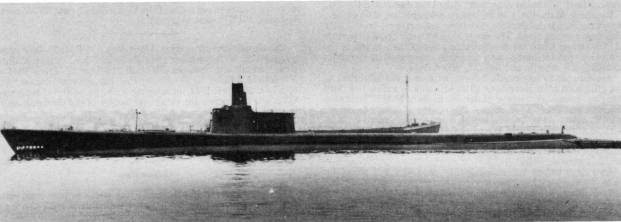
USS Albacore
U.S. counterattack
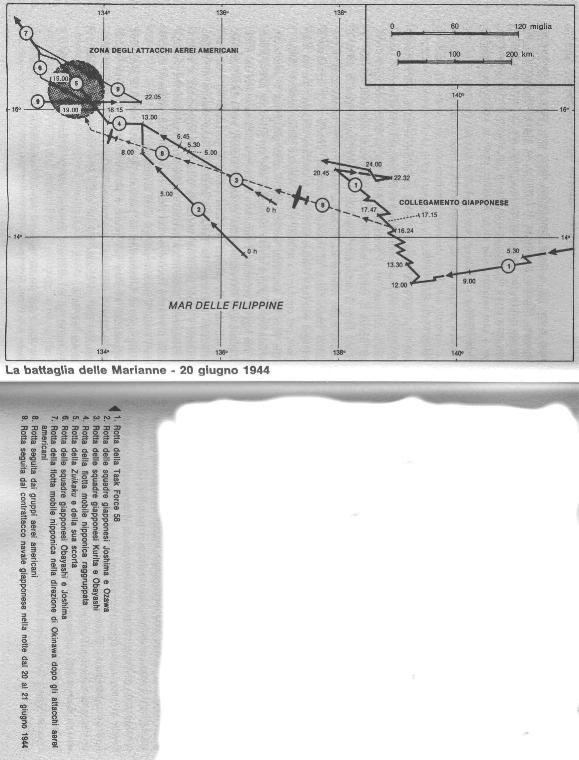
TF-58 sailed west during the night to attack the Japanese at dawn. Search patrols were put up at first light.

HIJMS Zuikaku
Admiral Ozawa had transferred to the destroyer Wakatsuki after Taihō had been hit, but the radio gear onboard wasn't capable of sending the number of messages needed, so he transferred again, to the carrier Zuikaku, at 13:00. It was then he learned of the disastrous results of the previous day and that he had about 150 aircraft left. Nevertheless, he decided to continue the attacks, thinking there were still hundreds of aircraft on Guam and Rota, and started planning new raids for June 21.
American searches failed to locate the Japanese fleet until 15:40. However, the report made was so garbled that Mitscher knew neither what had been sighted nor where. At 16:05, a clearer report was received, and Mitscher decided to launch a large strike, even though there were only 75 minutes until sunset and his aviators didn't normally land at night because of the risk of significant losses due to landing mishaps.

The tense faces of the pilots of VF-1 while preparing to take off on late afternoon of June 20, 1944

On the briefing blackboard the written: "Get the Carriers"
The attack went in at 18:30.
Ozawa had been able to put up very few fighters to intercept the incoming U.S. attack no more than 35, according to later estimates, but these few were skillfully handled, even though the Japanese antiaircraft fire was intense.

Japanese Carrier Division Three under attack by United States Navy aircraft from Task Force 58, late afternoon, June 20, 1944. The heavy cruiser circling at right, nearest to the camera, is either Maya or Chōkai. Beyond that, is the small aircraft carrier Chiyoda

HIJMS Hyio
The first ships sighted by the U.S. strike were oilers, and two of these were damaged so severely that they were later scuttled. The carrier Hiyo was attacked and hit by bombs and aerial torpedoes from four Grumman Avengers from Belleau Wood.
Hiyō was set afire after a tremendous blast from leaking aviation fuel. Dead in the water, she slipped stern first under the waves, taking the lives of 250 officers and men. The rest of her crew, about one thousand, survived to be rescued by Japanese destroyers.
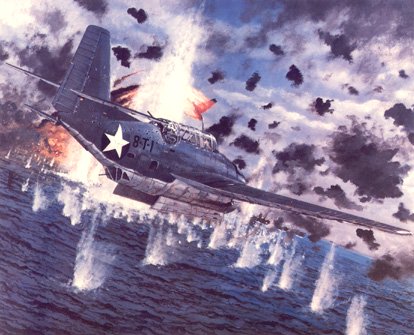
Grumman TBF-1 Avenger
The carriers Zuikaku, Junyō, and Chiyoda were damaged by bombs, as was the battleship Haruna. Twenty American aircraft were lost in this strike.

The Japanes leading Force under attack by aircraft of Task Force 58, late afternoon June 20
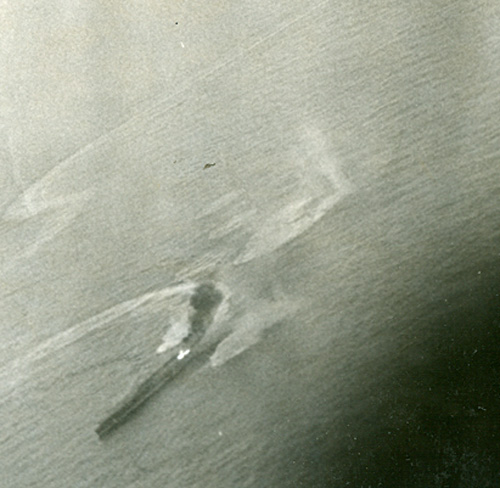
A fire column leave from a Japanese Carrier hit during the attack of June 20, 1944
At 20:45, the first U.S. aircraft began to return to TF 58. Knowing his aviators would have difficulty finding their carriers, Mitscher decided to fully illuminate his carriers, shining searchlights directly up into the night, despite the risk of attack from submarines and night-flying aircraft. Picket destroyers fired star shells to help the aircraft find the task groups. Despite this, 80 of the returning aircraft were lost, some crashing on flight decks, the majority going into the sea. Many of the crews were rescued over the next few days
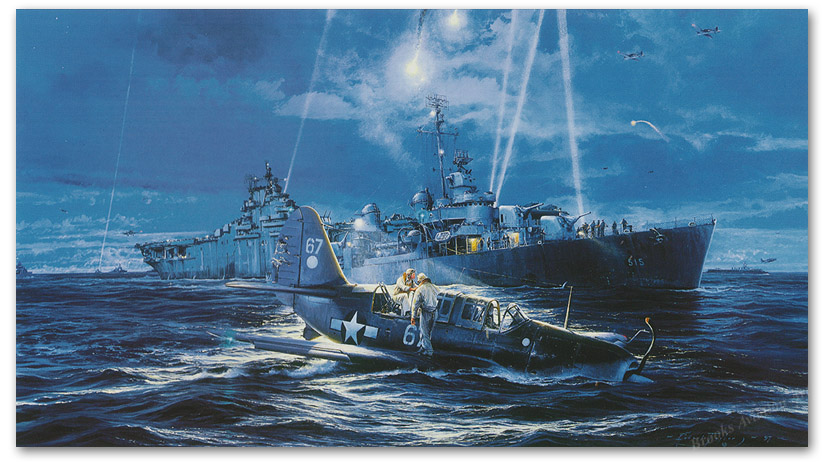
Night rescues
Aftermath
That night, Admiral Ozawa received orders from Toyoda to withdraw from the Philippine Sea. U.S. forces gave chase, but the battle was over.
The four Japanese air strikes involved 373 carrier aircraft, of which 130 returned to the carriers, and many more were lost on board when the two carriers were sunk on the first day by submarine attacks. After the second day the losses totaled three carriers, more than 433 carrier aircraft, and around 200 land-based aircraft. Losses on the U.S. side on the first day were only 23, and on the second 100, most of them resulting from the night landings.
The battle was nicknamed the 'Great Marianas Turkey Shoot' in American accounts, for the severely disproportional loss ratio inflicted upon Japanese aircraft by American pilots and anti-aircraft gunners. American forces suffered much lighter losses, and a pilot from the U.S.S. Lexington supposedly remarked that "This is like an old-time turkey shoot!" during the battle.
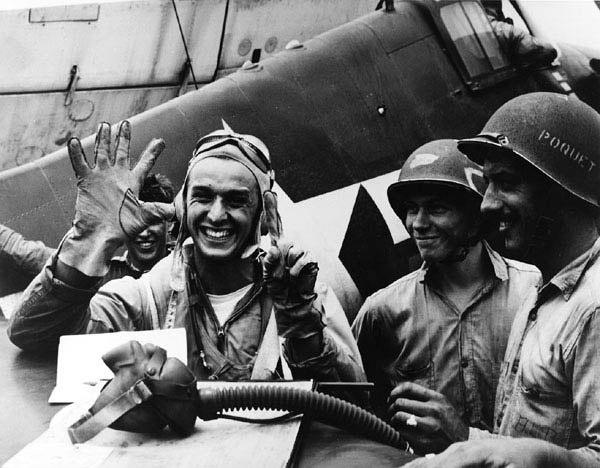
Lieutenant Alexander shows his air kills on board of USS Lexington
The lopsided outcome is generally attributed to American improvements in pilot and crew training and tactics, war technology, and ship and aircraft design, which the Japanese war machine could not match over the course of the war. Ultimately, the Imperial Japanese Navy lost three aircraft carriers, between 550 and 645 aircraft, and hundreds of pilots in addition to minor ships.
The losses to the Japanese were irreplaceable. Of the Japanese naval air arm, only 35 out of Admiral Ozawa's 473 aircraft were left in a condition fit to fly. In the Battle of Leyte Gulf a few months later, their carriers were used solely as a decoy because of the lack of aircraft and aircrews to fly them.
The Japanese Navy, which had not released the true accounts of the naval battles since the Battle of Midway (which they had presented as a victory), had revealed the actual accounts of the simultaneous Battle of Saipan to the public, but the extent of the disaster of the Battle of the Philippine Sea led them to continue the obfuscating of defeats with it.
The F6F had proved decisive in the battle. Its superior speed, firepower, and protection made it a formidable aircraft for the increasingly undertrained Japanese aircraft. Losing fewer than two dozen Hellcats, the American pilots were dominant during the battle racking up nearly 500 kills in two days alone.
Spruance was heavily criticized by many officers after the battle (and continues to be to this day) for his decision to initiate battle cautiously rather than exploiting his superior forces and intelligence data with a more aggressive posture; by failing to press the attack earlier and more forcefully, his critics argue, he might well have squandered the opportunity to envelop and destroy the entire Japanese strike force. However, it is instructive to compare Spruance's caution (particularly his suspicion of a diversionary force) with Admiral Halsey's later impetuous pursuit of an actual diversionary force at the Battle of Leyte Gulf that left inferior U.S. forces open to an attack off Samar by a Japanese surface action group composed of battleships, cruisers and destroyers. Furthermore, Spruance's conservative battle plan, while not destroying all of the Japanese aircraft carriers, did effectively drive the final nail into the coffin of the Japanese naval aviation forces by killing most of the remaining trained pilots and destroying their last operational reserves of naval aircraft. Without the time or resources to build sufficient aircraft and train experienced pilots, the surviving Japanese carriers were mere shadows of their former selves, a fact the Japanese recognized by using them as sacrificial decoys at Leyte Gulf. With the effective crippling of her best striking arm, Japan was increasingly forced to rely on land-based kamikaze suicide aircraft in a last-ditch effort to stave off total U.S. naval and air supremacy.
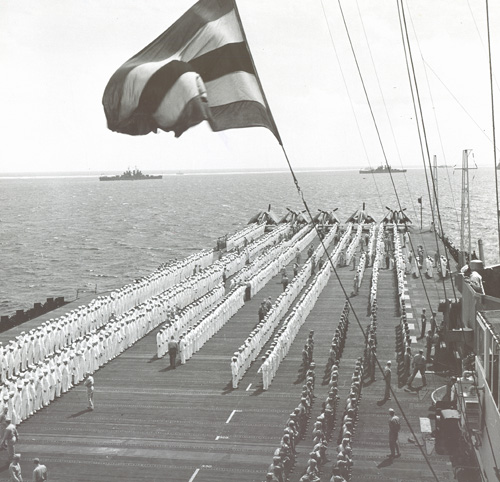
Crew aligned on USS Hornet bridge, after the Battle which left Japan without its air sea Power
Japanese losses:
3 Carriers sunk Shokaku, Taiho, Hiyo,
2 Oil Tankers sunk
circa 600 Aircraft destroyed
6 Ships heavy damaged
Casualties:
30.000 (Saipan Battle)
20.000 (Guam Battle)
3.000 (Tinian Battle)
USA losses:
1 Battleship damaged: USS South Dakota
123 Aircraft destroyed (80 crews survived)
Casualties:
14.021 (Saipan Battle)
7.800 (Guam Battle)
327 (Tinian Battle)

NOTES ON BATTLE
The lopsided outcome is generally attributed to American improvements in pilot and crew training and tactics, war technology, and ship and aircraft design, which the Japanese war machine could not match over the course of the war. These changes were because the Americans now utilized and were becoming practiced with the new radar-based Command Information Center concepts which, beginning with early stumbling initiatives in 1942 battles, continued to grow and morph and bear effectiveness in return for experimentation. The proof was in the vast amounts of anti-air defensive firepower delivered on target. Such institutional self-criticisms were very alien to Japanese society. Another clear benefit of the new doctrines and organizational measures was that, unlike the overburdened radio channels and lost messages experienced in the battle of Midway, the U.S. fleet had sufficient frequencies and communications training, discipline, experience and doctrine to maintain good command coordination and control during the largest such battle ever. So many planes were destroyed on the ground or intercepted transferring between bases that despite comparisons with captured surviving Japanese records, careful postwar analysis could not refine these estimates despite a massive prolonged effort.
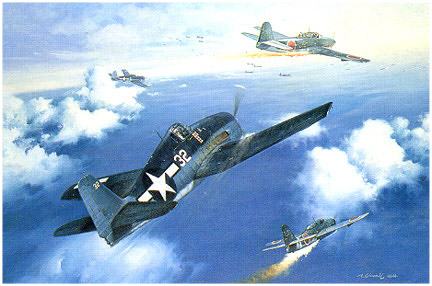
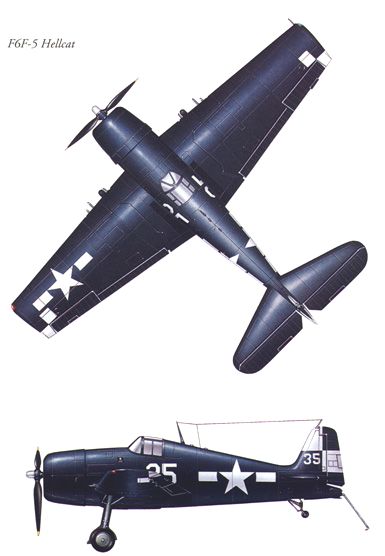
F6F-5 Hellcat
WHO RESOLVED THE BATTLE
It appears as a paradox but, the Major Carrier vs Carrier Battle of the History was resolved in favor of USA by the most perfidy sea weapon: the Submarine. It was in fact the American submarine "Cavalla" to sink, in quick series, the largest and most important Japanese Carriers: the new Taiho and the glorious Shokaku.

Hellcat vs Zero
___________________________________________________________________________________________________
ORDER OF BATTLE
on working...

Propeller blade of Japanese aircraft downed on Essex, June 19, 1944
Source: WIKIPEDIA, "PACIFIC WAR" by B. MILLOT
by care of R. Cipson
Giving our warmest Welcome to all IL-2 International Community to this new Event, thanking all Sqn. Teams for their participation, hoping a great amusement for all Pilots, recommending the maximum loyalty and fair play in spirit of Airmen Brotherhood, for the occasion please find hereinafter the Historical Background of those dramatic Events which, all together, we will try to reenact.
A Great Salute to All!
SEOW MARIANAS Org.
_________________________________________________________________________

Sea American Memorial, Philippines
THE MAJOR CARRIER VS CARRIER BATTLE IN HISTORY - MARIANAS ISLANDS, 19, 20 June 1944

Belligérants
 United States Fifth Fleet
United States Fifth FleetCommanders

Raymond A. Spruance

Marc A. Mitscher
Strength
7 Fleet Carriers
8 Light Carriers
7 Battleships
8 Cruisers
12 Light Cruisers
67 Minor Ships
22 Submariners
956 Aircraft
99.000 Personnel

USS Lexington CV16-10
 Japan Combined Fleet
Japan Combined Fleet
Jisaburo Ozawa

Kakuji Kakuta
Strength
5 Fleet Carriers
4 Light Carriers
5 Battleships
12 Cruisers
2 Light Cruisers
43 Other Ships
680 Aircraft (of which 250 land based aircraft)

HIJMS Taiho
The Battle of the Philippine Sea (June 19–20, 1944), well known also with the name of Marianas Battle, was a decisive naval battle of World War II which effectively eliminated the Imperial Japanese Navy's ability to conduct large-scale carrier actions. It took place during the United States' amphibious invasion of the Mariana Islands during the Pacific War. The battle was the fifth of five major "carrier-versus-carrier" engagements between American and Japanese naval forces, and involved elements of the United States Navy's Fleet as well as ships and land-based aircraft from the Imperial Japanese Navy's Combined Fleet and nearby island garrisons.

Map of Battle
Background
The Battle of the Philippine Sea came about as the Americans invaded Saipan because the Japanese staff judged that it could pin the American Fleet against the island while the Americans were protecting their transports and the beachhead. It was fought between the carrier aircraft put up by the United States Navy's Fleet and both the land based and carrier launched naval air craft launched by the Imperial Japanese Navy's Combined Fleet and Japan's island garrisons.
The Japanese naval staff had hoped to resume offensive carrier operations in early 1944 and was still training pilots and new carrier crews when it decided to counterattack against the U.S. invasion fleet attacking the beaches of Saipan in the first stages of its Mariana Islands invasion.
On 19 April 1943, Admiral Mineichi Koga succeeded Yamamoto as Commander in Chief of the Combined Fleet. Under his direction in September 1943, Imperial Japanese Navy Headquarters decided the time was right to return to the offensive in the Pacific. But soon, because U.S. forces were attacking Japanese-held islands in the course of its “island hopping campaign” attack against the Japanese Sea lines of communications (SLOCs) the offensives planned could not be sustained despite ample sufficient naval aircraft production rates. The lack of trained carrier pilots meant the air fleets could not be manned and the Americans were attacking the land bases.
The staff morphed their planning into a carrier assisted battle fleet attack on the U.S. invasion fleet that would be pinned protecting transports and forces just landed. This 'battleships are still king' conceptualization was still prevalent in some U.S. circles as well, but not among the operational commanders. The battle fleet sortie concept was very similar to that intended by the late Admiral Yamamoto in the battle of Midway. Many of the officers who had planned Midway were still on the General Staff of the Combined Fleet. In their planning it was believed that the lack of offensive air power could be addressed by deploying strong land-based air forces a natural connection, for Japan had taken pains build many bases that could control the SLOCs around themselves.
Operation A-Go
The initial plan was to attack the U.S. Pacific Fleet in early 1944 whenever it launched its next minor offensive. However, the U.S. fleet was integrating and training up multiple new technologies, vast reinforcements, and developing new operational doctrines that made it far more effective than the Japanese imagined. The U.S. fleet retook the offensive by going after the air bases in a succession of raids designed to deplete and defeat control of the SLOCs around each base. It had taken U.S. commanders over a year and a half to incorporate radar into their practices after the first radar sets were deployed. The Japanese commanders were far worse off, with no inkling of the power of the new technology.
In March, Japan's combined fleet again lost its commander in an aircraft, this time during a Pacific hurricane. Under direction of the newly appointed Commander in Chief of the Combined Fleet, Admiral Soemu Toyoda, a finalized plan for the new conditional 'offensive' dubbed "Plan A-Go", or "Operation A-Go" was adopted in early June 1944, then within weeks, quickly adapted to trap the American fleet now detected in the process of invading Saipan.
Strategically, the Japanese commanders considered Guam, Tinian, and Saipan as part of an inner air-sea defense ring of land based fighter and bomber bases surrounding and protecting their home islands. In the prior year, the U.S. fleet had worked its way over or past other such strongholds in their steady progression across the Central Pacific islands. Their offensive served to weaken the Japanese naval air capabilities, so the Imperial Staff calculated the Marianas would come under similar attack. While revising their offensive ambitions the Japanese staff also ordered prepared defenses and planning for various likely island bases they believed would be likely targets.
The Japanese war plan had from the start always been to inflict such severe and painful losses upon the Americans that the American public would become war weary and demand a negotiated settlement. American technological advances and material production capacity made this objective impossible by holding down U.S. casualties. American-Allied spirits didn't flag but grew more resolved as the war went on.
Furthermore, the U.S. commanders turned the strategy around on the Japanese. Admiral Chester W. Nimitz and General Douglas McArthur planned large fighter strikes to surprise, overwhelm and suppress local and nearby island air bases and their mobile forces eliminating the material assets needed for the Japanese plan to be effective. Both commands then followed up invading a select key Japanese base by amphibious assaults where they'd emplace their own bases before hopping farther up the Japanese supply chain (SLOC) to take other key strong points. This hopping step by step from key position to key position neutralized the remnant forces and war material left behind on the bypassed Japanese bases.
That McArthur's forces applied this strategy along the long length of New Guinea instead of against isolated island bases is immaterial, for the dense triple-canopy jungles of New Guinea effectively demanded Sea Lines of Communication just to move a few miles. Similarly, it didn't matter that the General's offensive strikes were led sometimes by borrowed aircraft carrier strikes or the Army Air Corps' long ranged P-38 fighters of the U.S. Fifth Air Force. These cut off garrisons effectively withered most of the time towards near starvation, except as they turned their energies and efforts to local food production and away from military operations as they could no longer be supplied save by submarine or daring but fuel wasteful high speed destroyer runs, and material deficiencies could no longer be fixed. Consequently, the Japanese more often than not evacuated units bypassed rather than continuing to stretch logistics supporting units in untenable situations.
The Japanese society, for cultural reasons had difficulty training replacement pilots and no long term preparatory training program had been anticipated in pre-war planning that would enable the country to overcome their tradition caused cultural bottleneck causing a shortage of new pilots until well into the war. Many of these air to air losses are also largely attributed to the obsolescence of the Japanese aircraft for where the United States had researched and designed entire new classes to cope with the Japanese early war equipment superiority. Culturally the Japanese war society's entrenchment in Bushido (way of the warrior) philosophy suggested few such similar improvements from the 'obedient unquestioning warriors' in the field sent up the ladder to the leadership in the top down cultural hierarchy. The Japanese simply had no such feedback mechanism to duplicate the free wheeling out-spoken American character providing quick and effective pointed complaint feedback to designers.[dubious – discuss]
Hence before the end of 1942 the allied navies had by and large overcome most of the technological edge's Japan's ships and planes had held at the war start and furthermore by mid-1943 had the improvements in rapid mass production or were already updating ships and deploying improved aircraft in a continual process of improvement to correct such deficiencies. The Allied educational training practices similarly had geared up and flexibly adapted to new developments, along the way totally revising the way the American fleet operated with the parallel development of both the Combat Information Center and doctrine, training and practices to get the most out of the new communications and sensor technologies.
Most of Japan's more skillful and experienced pilots had died during the two years of attrition of near continual engagements as the U.S. stabilized the theater in 1942 with the blooding battles at Coral Sea and Midway where they checked and all but stopped Japanese expansion. The war events then began draining down the talent level of Japan's land based air forces as well with progressive air fleet activities in the New Guinea campaign and the tentative U.S. offensive, the battle of attrition that was the Guadalcanal campaign which by the fall of 1942 had decimated the average skill level of Japan's land and sea based pilots by taking out the best of them in the grinding battles. In 1943-44 other island war engagements just exacerbated the problem from the Japanese point of view as the U.S. fast carrier task groups began purposefully to raid and pound Japanese island stronghold specifically to reduce their air power and ability to protect shipping.
Moreover, the U.S., Australian, and British cultures and societies had added a comparative flood of well trained systematically seasoned pilots themselves trained by seasoned pilots recently rotated from the front to the 'finishing school' training commands. Additional training and experience effects from the long pilot shortage was the resultant inexperience of the Japanese carrier deck crews, not just its newbie aircrews flying the same unimproved well understood planes with the same old weaknesses, for in contrast to the U.S. Navy's operational tempo which had grown steadily from mid-1943 Japan's older and newly commissioned aircraft carriers sat in port awaiting hastily trained pilots to arm and justify their existence while the U.S. Fleet had totally re-equipped with the more modern Grumman F6F Hellcat fighter, which was specifically designed to be superior to the Japanese Zero. Further, the increased operations had just further seasoned its better-trained and more experienced airmen and replacement, while training up fleet personnel from Seaman to Admiral on other important new developments from its Combat Information Center organized and directed fleet anti-air defenses, to radar-directed combat air patrols, and the deployment of the VT Fuze in ship-based anti-aircraft artillery where task group CIC's directed the massed gunfire of neighboring ships.
The Japanese fleet, commanded by Vice-Admiral Jisaburo Ozawa, consisted of five large carriers (Taihō, Shōkaku, Zuikaku, Junyō, and Hiyō), four light carriers (Ryuho, Chitose, Chiyoda, and Zuihō), five battleships (Yamato, Musashi, Kongō, Haruna and Nagato) and supporting cruisers, destroyers, and oilers.
On June 12, 1944 U.S. carriers started a series of air strikes on the Marianas, convincing Admiral Toyoda that the U.S. was preparing to invade. This move came as a surprise; the Japanese had expected the next U.S. target to be farther to the south, either the Carolines or the Palaus. Therefore, the Marianas were protected with only 50 land-based aircraft.

USA amphibious forces approaching Saipan
On June 13, U.S. forces began bombardment operations for invading Saipan; in response, Toyoda ordered a fleet-based counterattack. The main portions of the fleet, consisting of six carriers and several battleships, rendezvoused on June 16 in the western part of the Philippine Sea and completed refueling on June 17.


On Saipan sands
La porzione principale della flotta, consistente di sei portaerei e di numerose navi da battaglia si incontrò il 16 nella parte occidentale del Mare delle Filippine, completando i rifornimenti di carburante il 17 giugno successivo.



Landing on Saipan, Guam e Tinian
American response
The Japanese fleet was sighted on June 15 by American submarines and by the next day Admiral Raymond Spruance, commander of the U.S. 5th Fleet, was convinced that a major battle was at hand. By the afternoon of June 18, Vice Admiral Marc Mitscher, aboard his flagship (the carrier USS Lexington) had his Task Force 58 (the Fast Carrier Task Force) formed up near Saipan to meet the Japanese attack.
TF-58 consisted of five major groups. In front (to the west) was Vice Admiral Willis Lee's Task Group 58.7 (TG-58.7), the "Battle Line", consisting of seven fast battleships (Washington, North Carolina, Indiana, Iowa, New Jersey, South Dakota and Alabama). Just north of them was the weakest of the carrier groups, Rear Admiral William K. Harrill's TG-58.4 of three carriers (Essex, Langley and Cowpens). To the east, in a line running north to south, were three groups each containing four carriers: Rear Admiral Joseph Clark's TG-58.1 (Hornet, Yorktown, Belleau Wood and Bataan); Rear Admiral Alfred Montgomery's TG-58.2 (Bunker Hill, Wasp, Cabot and Monterey) and Rear Admiral John W. Reeves's TG-58.3 (Enterprise, Lexington, San Jacinto and Princeton). The capital ships were supported by eight heavy cruisers, 13 light cruisers, 58 destroyers, and 28 submarines.
Shortly before midnight on June 18, Admiral Chester W. Nimitz sent Spruance a message from Pacific Fleet Headquarters indicating that the Japanese flagship was approximately 350 miles (562 km) to the west-southwest of Task Force 58. This was stated as based on a "fix" obtained by radio direction-finding, but was more probably due to decryption of intercepted Japanese naval messages.
Mitscher realized that if Task Force 58 were to advance westward, there was a strong chance of a night surface encounter with Ozawa's forces. He therefore conferred with Lee and inquired whether Lee favored such an encounter. The battleship commander was not enthusiastic about a night engagement with Japanese surface forces, despite his new ships outclassing most of the Japanese battleships, feeling that his crews were not adequately trained for such an action. Shortly after his discussion with Lee, Mitscher asked Spruance for permission to head west during the night to reach what would be an ideal launch position for an all-out aerial assault on the enemy force at dawn.
However, Spruance refused. Throughout the run-up to the battle he had been concerned that the Japanese would try to draw his main fleet away from the landing area using a diversionary force, and would then make an attack around the flank of the U.S. carrier force, an "end run", hitting the invasion shipping off Saipan. He was therefore not prepared to let Task Force 58 be drawn westward, away from the amphibious forces, as he was aware that Japanese operational plans frequently relied on diversionary forces. On this occasion, however, there was no such aspect to the Japanese plan; there was no ruse and no diversionary force.
The Battle. First actions. June 19

Ozawa's Raids
At 05:30 on June 19, TF-58 turned northeast into the wind and started to launch their air patrols. The Japanese had already launched their morning search patrols using some of the 50 aircraft stationed on Guam, and at 05:50, one of these, a Mitsubishi Zero, found TF-58. After radioing his sighting of U.S. ships, he attacked one of the destroyers on picket duty and was shot down.

Fighter aircraft contrails mark the sky over Task Force 58, June 19, 1944
Thus alerted, the rest of the Guam forces began forming up for an attack, but were spotted on radar by U.S. ships, and a group of F6F Hellcats from the Belleau Wood were sent to investigate. The Hellcats arrived while aircraft were still launching from Orote Field. Minutes later, additional radar contacts were seen, which were later discovered to be the additional forces being sent north from the other islands. A huge battle broke out; 35 of the Japanese aircraft were shot down, and the battle was still going an hour later when the Hellcats were recalled to their carriers.

F6F-3 landing aboard 'Lexington' (CV-16) — Task Force 58 flagship

Battle Map, June 19
Japanese raids
The recall had been ordered after several ships in TF-58 picked up radar contacts 150 miles (240 km) to the west around 10:00. This was the first of the raids from the Japanese carrier forces, with 68 aircraft. TF-58 started launching every fighter it could, and by the time they were in the air, the Japanese had closed to 70 miles (110 km). However, the Japanese began circling to regroup their formations for the attack. This 10-minute delay proved critical, and the first group of Hellcats met the raid, still at 70 miles (110 km), at 10:36. They were quickly joined by additional groups. Within minutes, 25 Japanese aircraft had been shot down, against the loss of only one U.S. aircraft.

Japanese aircraft dive in flame
The Japanese aircraft that survived were met by other fighters, and 16 more were shot down. Of the remainder, some made attacks on the picket destroyers USS Yarnall and USS Stockham but caused no damage. Three or four bombers broke through to Lee's battleship group, and one made a direct hit on the USS South Dakota, which caused many casualties, but failed to disable her, being the only Japanese success throughout the battle. Not one aircraft of Ozawa’s first wave got through to the American carriers

USS South Dakota
At 11:07, radar detected another, much larger attack. This second wave consisted of 107 aircraft. They were met while still 60 miles (97 km) out, and at least 70 of these aircraft were shot down before reaching the ships. Six attacked Rear Admiral Montgomery’s group, nearly hitting two of the carriers and causing casualties on each. Four of the six were shot down. A small group of torpedo aircraft attacked Enterprise, one torpedo exploding in the wake of the ship. Three other torpedo-aircraft attacked the light carrier Princeton but were shot down. In all, 97 of the 107 attacking aircraft were destroyed.

Air attacks against the Task force 58, morning June 19
The third raid, consisting of 47 aircraft, came in from the north. It was intercepted by 40 fighters at 13:00, while 50 miles (80 km) out from the task force. Seven Japanese aircraft were shot down. A few broke through and made an ineffective attack on the Enterprise group. Many others did not press home their attacks. This raid therefore suffered less than the others, and 40 of its aircraft managed to return to their carriers.
USS Bunker Hill is nearly hit by a Japanese bomb during the air attacks of June 19, 1944.The fourth Japanese raid was launched between 11:00 and 11:30, but pilots had been given an incorrect position for the US fleet and could not locate it. They then broke into two loose groups and turned for Guam and Rota to refuel. One group flying toward Rota stumbled upon Montgomery’s task group. Eighteen aircraft joined battle with American fighters and lost half their number. A smaller group of nine Japanese dive bombers of this force evaded U.S. aircraft and made attacks on the USS Wasp and the USS Bunker Hill, but failed to make any hits. Eight of these aircraft were shot down in the process. The larger group of Japanese aircraft had flown to Guam and were intercepted over Orote Field by 27 Hellcats while landing. Thirty of the 49 Japanese aircraft were shot down, and the rest were damaged beyond repair.

USS Bunker Hill is nearly hit by a Japanese bomb during the air attacks of June 19, 1944.
Aboard the Lexington afterward, a pilot was heard to remark "Hell, this is like an old-time turkey shoot!" Since then, this lopsided air battle has been known as the “Great Marianas Turkey Shoot”.
Including the continued aerial slaughter over Orote Field, Japanese losses exceeded 350 planes on the first day of battle. American losses were slight, about thirty planes were lost. American ship damage was minimal.
Most of those who successfully evaded the US fighter screens were aviators who were seasoned veterans of the six-month Japanese advance early in the Pacific war, the South Pacific campaign and survivors of the Battle of Midway.
Submarine attacks

HIJMS Taiho
At 08:16 the submarine USS Albacore had sighted Ozawa’s own carrier group and began an attack on the closest carrier, which was Taihō, the largest and newest carrier in the Japanese fleet and Vice Admiral Jisaburo Ozawa’s flagship. As Albacore was about to fire, however, her fire-control computer failed, and the torpedoes had to be fired “by eye”.
Taihō had just launched 42 aircraft as a part of the second raid. Four of Albacore’s torpedoes were off-target. Sakio Komatsu, the pilot of one of the recently-launched aircraft, sighted one of the two which were heading for Taihō and crashed his aircraft on it, but the last torpedo struck the carrier on her starboard side, rupturing two aviation-fuel tanks. At first, the damage did not appear to be very serious.

HIJMS Shokaku
Another submarine, USS Cavalla, was able to maneuver to an attack position on the 25,675-ton carrier Shōkaku by about noon. The submarine fired a spread of six torpedoes, three of which struck the Shōkaku. Badly damaged, the carrier came to a halt. One torpedo had hit the forward aviation fuel tanks near the main hangar, and aircraft that had just landed and were being refueled exploded into flames. Ammunition and exploding bombs added to the conflagration, as did burning fuel spewing from shattered fuel pipes. With her bows subsiding into the sea and fires out of control, the captain gave orders to abandon ship. Within minutes, total catastrophe struck the vessel. Volatile gas fumes had accumulated throughout the vessel, and when an aerial bomb exploded on the hangar deck, a series of terrific explosions simply blew the ship apart about 140 miles (230 km) north of the island of Yap. The carrier rolled over and slid beneath the waves taking 887 navy officers and men plus 376 men of Air Group 601, a total of 1,263 men in all, to the seabed. There were 570 survivors, including the carrier's commander, Captain Hiroshi Matsubara. Futile attempts were made by destroyer Urakaze to destroy the submarine, but Cavalla escaped with relatively minor damage due to depth charge near misses from Urakaze.
Meanwhile, Taihō was falling victim to poor damage control. On the orders of an inexperienced damage-control officer, her ventilation system had been operating at full-blast in an attempt to clear explosive fumes from the ship. This instead had the effect of spreading the vapors throughout Taihō. At 17:32, she suffered a series of catastrophic explosions caused by the accumulated fumes igniting near an electric generator on the hangar deck. Of her complement of 1,751, a total of 1,650 crewmen were lost.

USS Albacore
U.S. counterattack

TF-58 sailed west during the night to attack the Japanese at dawn. Search patrols were put up at first light.

HIJMS Zuikaku
Admiral Ozawa had transferred to the destroyer Wakatsuki after Taihō had been hit, but the radio gear onboard wasn't capable of sending the number of messages needed, so he transferred again, to the carrier Zuikaku, at 13:00. It was then he learned of the disastrous results of the previous day and that he had about 150 aircraft left. Nevertheless, he decided to continue the attacks, thinking there were still hundreds of aircraft on Guam and Rota, and started planning new raids for June 21.
American searches failed to locate the Japanese fleet until 15:40. However, the report made was so garbled that Mitscher knew neither what had been sighted nor where. At 16:05, a clearer report was received, and Mitscher decided to launch a large strike, even though there were only 75 minutes until sunset and his aviators didn't normally land at night because of the risk of significant losses due to landing mishaps.

The tense faces of the pilots of VF-1 while preparing to take off on late afternoon of June 20, 1944

On the briefing blackboard the written: "Get the Carriers"
The attack went in at 18:30.
Ozawa had been able to put up very few fighters to intercept the incoming U.S. attack no more than 35, according to later estimates, but these few were skillfully handled, even though the Japanese antiaircraft fire was intense.

Japanese Carrier Division Three under attack by United States Navy aircraft from Task Force 58, late afternoon, June 20, 1944. The heavy cruiser circling at right, nearest to the camera, is either Maya or Chōkai. Beyond that, is the small aircraft carrier Chiyoda

HIJMS Hyio
The first ships sighted by the U.S. strike were oilers, and two of these were damaged so severely that they were later scuttled. The carrier Hiyo was attacked and hit by bombs and aerial torpedoes from four Grumman Avengers from Belleau Wood.
Hiyō was set afire after a tremendous blast from leaking aviation fuel. Dead in the water, she slipped stern first under the waves, taking the lives of 250 officers and men. The rest of her crew, about one thousand, survived to be rescued by Japanese destroyers.

Grumman TBF-1 Avenger
The carriers Zuikaku, Junyō, and Chiyoda were damaged by bombs, as was the battleship Haruna. Twenty American aircraft were lost in this strike.

The Japanes leading Force under attack by aircraft of Task Force 58, late afternoon June 20

A fire column leave from a Japanese Carrier hit during the attack of June 20, 1944
At 20:45, the first U.S. aircraft began to return to TF 58. Knowing his aviators would have difficulty finding their carriers, Mitscher decided to fully illuminate his carriers, shining searchlights directly up into the night, despite the risk of attack from submarines and night-flying aircraft. Picket destroyers fired star shells to help the aircraft find the task groups. Despite this, 80 of the returning aircraft were lost, some crashing on flight decks, the majority going into the sea. Many of the crews were rescued over the next few days

Night rescues
Aftermath
That night, Admiral Ozawa received orders from Toyoda to withdraw from the Philippine Sea. U.S. forces gave chase, but the battle was over.
The four Japanese air strikes involved 373 carrier aircraft, of which 130 returned to the carriers, and many more were lost on board when the two carriers were sunk on the first day by submarine attacks. After the second day the losses totaled three carriers, more than 433 carrier aircraft, and around 200 land-based aircraft. Losses on the U.S. side on the first day were only 23, and on the second 100, most of them resulting from the night landings.
The battle was nicknamed the 'Great Marianas Turkey Shoot' in American accounts, for the severely disproportional loss ratio inflicted upon Japanese aircraft by American pilots and anti-aircraft gunners. American forces suffered much lighter losses, and a pilot from the U.S.S. Lexington supposedly remarked that "This is like an old-time turkey shoot!" during the battle.

Lieutenant Alexander shows his air kills on board of USS Lexington
The lopsided outcome is generally attributed to American improvements in pilot and crew training and tactics, war technology, and ship and aircraft design, which the Japanese war machine could not match over the course of the war. Ultimately, the Imperial Japanese Navy lost three aircraft carriers, between 550 and 645 aircraft, and hundreds of pilots in addition to minor ships.
The losses to the Japanese were irreplaceable. Of the Japanese naval air arm, only 35 out of Admiral Ozawa's 473 aircraft were left in a condition fit to fly. In the Battle of Leyte Gulf a few months later, their carriers were used solely as a decoy because of the lack of aircraft and aircrews to fly them.
The Japanese Navy, which had not released the true accounts of the naval battles since the Battle of Midway (which they had presented as a victory), had revealed the actual accounts of the simultaneous Battle of Saipan to the public, but the extent of the disaster of the Battle of the Philippine Sea led them to continue the obfuscating of defeats with it.
The F6F had proved decisive in the battle. Its superior speed, firepower, and protection made it a formidable aircraft for the increasingly undertrained Japanese aircraft. Losing fewer than two dozen Hellcats, the American pilots were dominant during the battle racking up nearly 500 kills in two days alone.
Spruance was heavily criticized by many officers after the battle (and continues to be to this day) for his decision to initiate battle cautiously rather than exploiting his superior forces and intelligence data with a more aggressive posture; by failing to press the attack earlier and more forcefully, his critics argue, he might well have squandered the opportunity to envelop and destroy the entire Japanese strike force. However, it is instructive to compare Spruance's caution (particularly his suspicion of a diversionary force) with Admiral Halsey's later impetuous pursuit of an actual diversionary force at the Battle of Leyte Gulf that left inferior U.S. forces open to an attack off Samar by a Japanese surface action group composed of battleships, cruisers and destroyers. Furthermore, Spruance's conservative battle plan, while not destroying all of the Japanese aircraft carriers, did effectively drive the final nail into the coffin of the Japanese naval aviation forces by killing most of the remaining trained pilots and destroying their last operational reserves of naval aircraft. Without the time or resources to build sufficient aircraft and train experienced pilots, the surviving Japanese carriers were mere shadows of their former selves, a fact the Japanese recognized by using them as sacrificial decoys at Leyte Gulf. With the effective crippling of her best striking arm, Japan was increasingly forced to rely on land-based kamikaze suicide aircraft in a last-ditch effort to stave off total U.S. naval and air supremacy.

Crew aligned on USS Hornet bridge, after the Battle which left Japan without its air sea Power
Japanese losses:
3 Carriers sunk Shokaku, Taiho, Hiyo,
2 Oil Tankers sunk
circa 600 Aircraft destroyed
6 Ships heavy damaged
Casualties:
30.000 (Saipan Battle)
20.000 (Guam Battle)
3.000 (Tinian Battle)
USA losses:
1 Battleship damaged: USS South Dakota
123 Aircraft destroyed (80 crews survived)
Casualties:
14.021 (Saipan Battle)
7.800 (Guam Battle)
327 (Tinian Battle)

NOTES ON BATTLE
The lopsided outcome is generally attributed to American improvements in pilot and crew training and tactics, war technology, and ship and aircraft design, which the Japanese war machine could not match over the course of the war. These changes were because the Americans now utilized and were becoming practiced with the new radar-based Command Information Center concepts which, beginning with early stumbling initiatives in 1942 battles, continued to grow and morph and bear effectiveness in return for experimentation. The proof was in the vast amounts of anti-air defensive firepower delivered on target. Such institutional self-criticisms were very alien to Japanese society. Another clear benefit of the new doctrines and organizational measures was that, unlike the overburdened radio channels and lost messages experienced in the battle of Midway, the U.S. fleet had sufficient frequencies and communications training, discipline, experience and doctrine to maintain good command coordination and control during the largest such battle ever. So many planes were destroyed on the ground or intercepted transferring between bases that despite comparisons with captured surviving Japanese records, careful postwar analysis could not refine these estimates despite a massive prolonged effort.


F6F-5 Hellcat
WHO RESOLVED THE BATTLE
It appears as a paradox but, the Major Carrier vs Carrier Battle of the History was resolved in favor of USA by the most perfidy sea weapon: the Submarine. It was in fact the American submarine "Cavalla" to sink, in quick series, the largest and most important Japanese Carriers: the new Taiho and the glorious Shokaku.

Hellcat vs Zero
___________________________________________________________________________________________________
ORDER OF BATTLE
on working...

Propeller blade of Japanese aircraft downed on Essex, June 19, 1944
Source: WIKIPEDIA, "PACIFIC WAR" by B. MILLOT
by care of R. Cipson